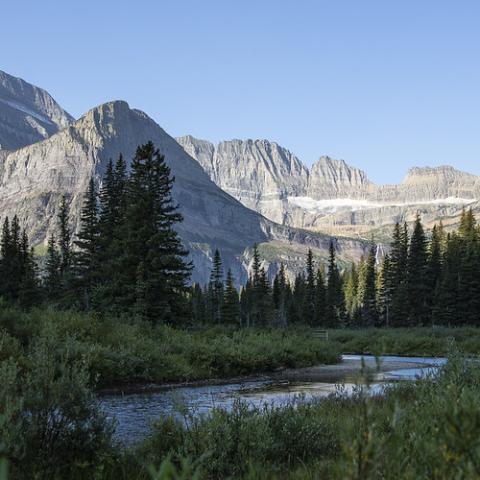
A lawsuit will be filed against BNSF Railway in connection with the deaths of grizzly bears killed by trains or "rail activities"/NPS file
BNSF Railway Company is the target of a forthcoming lawsuit accusing the railroad of negligently killing grizzly bears, which are protected under the Endangered Species Act, near Glacier National Park in Montana.
Wildlife Guardians, supported by Western Environmental Law Center, late in October notified BNSF of its intent to sue over the bear deaths. The notice came shortly after two bear cubs were killed by a train near Whitefish. Back in June three bears -- a sow and her two cubs -- were hit and killed by a train near Marias Pass just south of Glacier National Park.
According to Wildlife Guardians,five grizzlies were killed by "railway activities" near East Glacier in October. A train struck and killed a cow, which then attracted five bears to the tracks. In five separate incidents, two died in train collisions and three were killed by cars on Highway 2, the group said in a release.
“While Burlington Northern has twiddled its thumbs for 15 years rather than taking essential measures to protect grizzly bears, trains have killed dozens of grizzlies, including at least four cubs,” said Sarah McMillan, conservation director at WildEarth Guardians. “This neglect, that has such lethal impact on protected bears, is simply unacceptable.”
The advocacy group said that, according to best available data, from 1980-2018 trains killed or contributed to the deaths of approximately 52 grizzly bears from the Northern Continental Divide Ecosystem.
Approximately 1.2-1.5 BNSF trains run per hour on these railways in Montana, averaging 35 miles per hour. There is a slight increase in train frequency at twilight, when grizzly bears often feed, the group said.
“The 67-mile stretch of railway between West Glacier and Browning is where trains reportedly killed 29 grizzlies between 1980 and 2002,” said Pete Frost, attorney at the Western Environmental Law Center. “Slowing the trains down, ensuring carrion are promptly cleared from tracks, and perhaps scheduling trains to run during the day and not at feeding time might reduce trains killing grizzlies.”
“The deaths of these grizzly bears and cubs was entirely preventable and there is no excuse for Burlington Northern’s continued failure to safeguard the railroad from these lethal collisions,” said Josh Osher, Montana Director for Western Watersheds Project. “Whether it’s a lack of concern, laziness or just plain greed, it’s time for BNSF to be held accountable and to take immediate steps to stop further killings.”
When a company’s activities kill threatened species like the grizzly bear, it is legally required to propose solutions in a habitat conservation plan that then can lead to an incidental take permit, the groups said.
BNSF officials told The Associated Press that crews work to remove carrion and spilled grain, which attracts bears, from the tracks.




 Support Essential Coverage of Essential Places
Support Essential Coverage of Essential Places







Comments
Less than two bears a year out of a population of 40,000+. Really?
What is the source for your 40,000+ population number? I'm sure you're more of a "lumper" than a "splitter" when it comes to taxonomy; but, that number is far higher than any credible number I've ever heard for that DPS.
You are right rump, my number was off. Low by about 50%
1,200+ US, 25,000 Canada, 40,000 Alaska
https://alaskatrekker.com/alaska-wildlife/alaska-bear/
https://www.tourguidecanada.com/grizzlies-in-canada.html
http://igbconline.org/conserving-grizzly-populations-2/
So, 1,200+ is the closest thing to a credible number relevant to the topic of the article. The other two numbers are not even remotely peer reviewed, come from highly questionable sources that are very likely tainted by conflict of interest, and are purported to describe populations that are only marginally linked to the DPS addressed in the article.
When a guy who makes his living boosting bear hunting trips to Alaska tells me there's 40,000 grizzlies to hunt up there or when some Canadian tour guide tells me to come up to see the 25,000 grizzlies his associates can show me, I'm not going to just take their word on what might be horrendously or even dishonestly exaggerated numbers. But, far more important, wildlife populations are not all the same, even within what taxonomic "lumpers" might like consider the same species. Yes, Glacier is more connected to the more northerly populations than Yellowstone; however, even that genetic exchange rate is very low due to distance, terrain, and human interference. And, that's not all bad. Populations that get genetically isolated, by distance or terrain or climate, can be the trailbreakers of evolution. As long as their gene pool stays large enough to counteract inbreeding problems, isolated populations can be the ones to evolve adaptations to changing conditions, like climate change.
Unfortunately, a nominal gene pool of 1,200+ is far too small and, in the case of the Glacier DPS, there is really not enough genetic exchange with other populations to reliably avoid inbreeding, which means that anything causing the needless loss of even a few bears out of this small population needs to be looked at closely to see how the losses could be avoided. I have BNSF in my portfolio and want to see it do well; however, the Western Environmental Law Center thinks "Slowing the trains down, ensuring carrion are promptly cleared from tracks, and perhaps scheduling trains to run during the day and not at feeding time might reduce trains killing grizzlies." And, I support exploring these ideas, especially since, if we are successful in expanding the Glacier population as a means to prevent inbreeding, the kill rate on the tracks will likely increase unless we start working on solutions now.
So, why did I take the time to make a big deal over bear population numbers? Because, as I have said before and will obviously need to continue saying, there are a lot of young or otherwise poorly educated folks out there who get exposed to your nonsense and actually start believing it. In that sense, you are much more than just a useless crackpot; you genuinely constitute a conservation menace.
Ha. Schedule trains during the day? People do not understand railroads XD.
So Rump, provide us sources other than your need to speculate to not look foolish that the Alaskan and Canadian numbers cited are wrong. This one says 25-29k in Canada. It is biased? https://www.thecanadianencyclopedia.ca/en/article/grizzly-bear
Is the Alaska Department of Wildlife lying? http://www.adfg.alaska.gov/index.cfm?adfg=brownbearhunting.main
Well, you sure dialed the wrong number on that one. Yes, I actually do understand railroads, far more thoroughly than you might imagine; I probably understand them and their operations at both a much higher, as well as more detailed, level than most railroad veterans; and railroads most certainly can be scheduled to run during the day or, at the very least, to reduce the traffic traversing the stretch near Glacier during the twilight hours. Will it be inconvenient and perhaps a bit less profitable to do so? Absolutely yes; but, as I have already pointed out, I have BNSF in my portfolio and I, for one, would accept the hit.
So, again, I have to point out that perhaps the most lamentable aspect of the "truth by emphatic assertion" that spews from so many of the poseurs we have today is that there are a lot of young or otherwise poorly educated folks out there who read or listen to what is really nonsense and start believing it. In that sense, these characters are much more than just harmless crackpots; they genuinely damage and pervert rational discussions that truly do need to take place.
Bucky, the Alaska Department of Fish and Game website you offered cites an estimated 30,000 brown bears in Alaska, rather than the 40,000+ number you quoted earlier. That 30,000 number does seem to be recent and therefore credible, but only if you "lump" all brown bears in Alaska into a single gene pool and, for the purposes of this discussion, assert that the Glacier bears fall into that same gene pool. Most conservation biologists would balk at that much "lumping" of taxonomy.
I don't want to throw too many rocks at the Canadian Encyclopedia. It's a good general source; I like it; and it does offer numbers close to yours, but, those numbers are a bit dated. The most recent credible original sources for those kinds of numbers all seem to be close to twenty years old and there have been some declines in the bear populations up there since then.
The issue remains what you "lump" together in the same taxonomic bin. To assert that the brown bears in Alaska and Canada should somehow be counted in the same DPS or gene pool with Glacier grizzlies would mean that you consider the Kodiak bear (Ursus arctos middendorffi), characterized by 1,400 pound relatively docile boars, to be the same as grizzlies in Glacier and Yellowstone (Ursus arctos horribilis), known for 700 pound boars that have much, much "hotter" dispositions. Again, aside from the usual "nurture or nature" arguments, most conservation biologists would balk at that assertion.
Do you not "get" this concept?